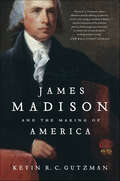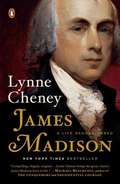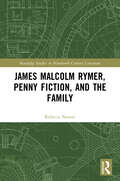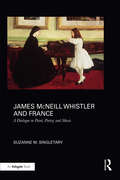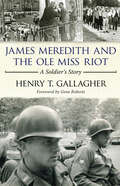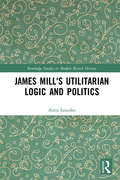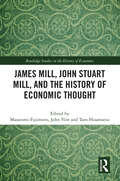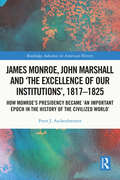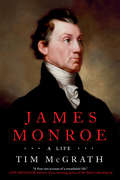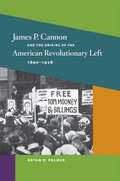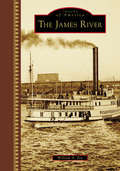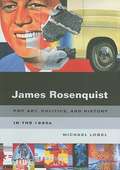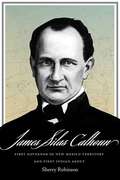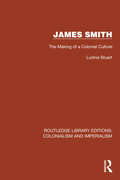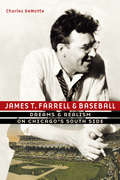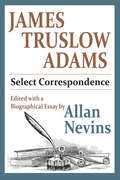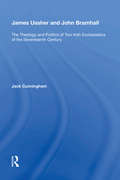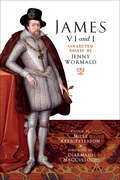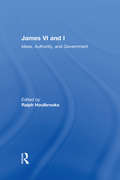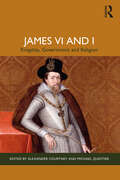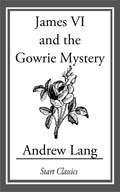- Table View
- List View
James Madison and Constitutional Imperfection
by Jeremy D. BaileyThis book presents a provocative account of James Madison's political thought by focusing on Madison's lifelong encounter with the enduring problem of constitutional imperfection. In particular, it emphasizes Madison's alliance with Thomas Jefferson, liberating it from those long-standing accounts of Madisonian constitutionalism that emphasize deliberation by elites and constitutional veneration. Contrary to much of the scholarship, this book shows that Madison was aware of the limits of the inventions of political science and held a far more subtle understanding of the possibility of constitutional government than has been recognized. By repositioning Madison as closer to Jefferson and the Revolution of 1800, this book offers a reinterpretation of one of the central figures of the early republic.
James Madison and the Making of America
by Kevin R. GutzmanIn James Madison and the Making of America, historian Kevin Gutzman looks beyond the way James Madison is traditionally seen -- as "The Father of the Constitution" -- to find a more complex and sometimes contradictory portrait of this influential Founding Father and the ways in which he influenced the spirit of today's United States. Instead of an idealized portrait of Madison, Gutzman treats readers to the flesh-and-blood story of a man who often performed his founding deeds in spite of himself: Madison's fame rests on his participation in the writing of The Federalist Papers and his role in drafting the Bill of Rights and Constitution. Today, his contribution to those documents is largely misunderstood. He thought that the Bill of Rights was unnecessary and insisted that it not be included in the Constitution, a document he found entirely inadequate and predicted would soon fail. Madison helped to create the first American political party, the first party to call itself "Republican", but only after he had argued that political parties, in general, were harmful. Madison served as Secretary of State and then as President during the early years of the United States and the War of 1812; however, the American foreign policy he implemented in 1801-1817 ultimately resulted in the British burning down the Capitol and the White House. In so many ways, the contradictions both in Madison's thinking and in the way he governed foreshadowed the conflicted state of our Union now. His greatest legacy—the disestablishment of Virginia's state church and adoption of the libertarian Virginia Statute for Religious Freedom—is often omitted from discussion of his career. Yet, understanding the way in which Madison saw the relationship between the church and state is key to understanding the real man. Kevin Gutzman's James Madison and the Making of America promises to become the standard biography of our fourth President.
James Madison: A Life Reconsidered
by Lynne Cheney<P>A major new biography of the fourth president of the United States by New York Times bestselling author Lynne Cheney <P>This majestic new biography of James Madison explores the astonishing story of a man of vaunted modesty who audaciously changed the world. Among the Founding Fathers, Madison was a true genius of the early republic. <P>Outwardly reserved, Madison was the intellectual driving force behind the Constitution and crucial to its ratification. His visionary political philosophy and rationale for the union of states--so eloquently presented in The Federalist papers--helped shape the country Americans live in today. Along with Thomas Jefferson, Madison would found the first political party in the country's history--the Democratic Republicans. <P>As Jefferson's secretary of state, he managed the Louisiana Purchase, doubling the size of the United States. As president, Madison led the country in its first war under the Constitution, the War of 1812. Without precedent to guide him, he would demonstrate that a republic could defend its honor and independence--and remain a republic still. <P><b>A New York Times Bestseller</b>
James Madison: America's First Politician
by Jay CostAn intellectual biography of James Madison, arguing that he invented American politics as we know it How do you solve a problem like James Madison? The fourth president is one of the most confounding figures in early American history; his political trajectory seems almost intentionally inconsistent. He was both for and against a strong federal government. He wrote about the dangers of political parties in the Federalist Papers and then helped to found the Republican Party just a few years later. This so-called Madison problem has occupied scholars for ages. As Jay Cost shows in this incisive new biography, the underlying logic of Madison&’s seemingly mixed record comes into focus only when we understand him primarily as a working politician. Whereas other founders split their time between politics and other vocations, Madison dedicated himself singularly to the work of politics and ultimately developed it into a distinctly American idiom. He was, in short, the first American politician.
James Malcolm Rymer, Penny Fiction, and the Family (Routledge Studies in Nineteenth Century Literature)
by Rebecca NesvetJames Malcolm Rymer, Penny Fiction, and the Family is the first monograph focusing on Sweeney Todd and Varney the Vampyre’s creator James Malcolm Rymer (1814–1884). It argues that Rymer wrote his so-called ‘penny bloods’ and ‘dreadfuls’ for and about British urban working families. In the 1840s, the notion of the family acquired unprecedented prominence and radical potential. Raised in an artisanal artistic-literary family, Rymer wrote for and edited family magazines early in that genre’s history, deployed Chartist domesticity to liberal ends, and collaborated with cheap publisher Edward Lloyd to define and popularise the domestic romance genre. In 1850s–1860s penny serials published by George W.M. Reynolds, John Dicks, and Lloyd, Rymer showed how families might sustain Empire and advocated for patriarchal family dynamics in response to literary and political change. During the fin-de-siècle, Rymer’s penny fiction was demonised as hyper-masculine ‘bloods’ and ‘dreadfuls’, a reputation it retains today. Reading Victorian penny fiction’s most indicative author’s works as a corpus and with attention to their original textual, cultural, and political contexts reveals it as the family-oriented phenomenon it in fact was.
James McNeill Whistler and France: A Dialogue in Paint, Poetry, and Music
by Suzanne SingletaryJames McNeill Whistler and France: A Dialogue in Paint, Poetry, and Music is the first full-length and in-depth study to position this painter within the overall trajectory of French modernism during the second half of the nineteenth century and to view the artist as integral to the aesthetic projects of its most original contributors. Suzanne M. Singletary maintains that Whistler was in a unique situation as an insider within the emerging French avant-garde, thereby in an enviable position to both absorb and transform the innovations of others – and that until now, his widespread influence as a catalyst among his colleagues has been neither investigated nor appreciated. Singletary contends that Whistler’s importance rivals that of Manet, whose multi-layered (and often unexpected) interconnections with Whistler are the focus of one chapter. In addition, Whistler’s pivotal role in linking the legacies of Baudelaire, Delacroix, Gautier, Wagner, and other mid-century innovators to the later French Symbolists has previously been largely ignored. Courbet, Degas, Monet, and Seurat complete the roster of French artists whose dialogue with Whistler is highlighted.
James Meredith and the Ole Miss Riot: A Soldier's Story
by Henry T. GallagherIn September 1962, James Meredith became the first African American admitted to the University of Mississippi. A milestone in the civil rights movement, his admission triggered a riot spurred by a mob of three thousand whites from across the South and all but officially stoked by the state's segregationist authorities. Historians have called the Oxford riot nothing less than an insurrection and the worst constitutional crisis since the Civil War. The escalating conflict prompted President John F. Kennedy to send twenty thousand regular army troops, in addition to federalized Mississippi National Guard soldiers, into the civil unrest (ten thousand into the town itself) to quell rioters and restore law and order. James Meredith and the Ole Miss Riot is the memoir of one of the participants, a young army second lieutenant named Henry Gallagher, born and raised in Minnesota. His military police battalion from New Jersey deployed, without the benefit of riot-control practice or advance briefing, into a deadly civil rights confrontation. He was thereafter assigned as the officer-in-charge of Meredith's security detail at a time when he faced very real threats to his life. Gallagher's first-person account considers the performance of his fellow soldiers before and after the riot. He writes of the behavior of the white students, some of them defiant, others perceiving a Communist-inspired Kennedy conspiracy in Meredith's entry into Mississippi's “flagship” university. The author depicts the student, Meredith, a man who at times seemed disconnected with the violent reality that swirled around him, and who even aspired to be freed of his protectors so that he could just be another Ole Miss student. James Meredith and the Ole Miss Riot is both an invaluable perspective on a pivotal moment in American history and an in-depth look at a unique home front military action. From the vantage of the fiftieth anniversary of the riot, Henry T. Gallagher reveals the young man he was in the midst of one of history's most profound tests, a soldier from the Midwest encountering the powder keg of the Old South and its violent racial divisions.
James Mill's Utilitarian Logic and Politics (Routledge Studies in Modern British History)
by Antis LoizidesJames Mill’s (1773–1836) role in the development of utilitarian thought in the nineteenth century has been overshadowed both by John Stuart Mill (1806–1873) and by Jeremy Bentham (1748–1832). Of the three, the elder Mill is considered to be the least original and with the least important, if any, contributions to utilitarian theory. True as this statement may be, even those who have tried to challenge some of its aspects take the common portrayal of Mill – "the rationalist, the maker of syllogisms, the geometrician" – as given. This book does not. Studying James Mill’s background has surprising results with reference to influences outside the Benthamite tradition as well as unexpected implications for his contributions to debates of his time. The book focuses on his political ideas, the ways in which he communicated them and the ways in which he formed them in an attempt to reveal a portrait of Mill unencumbered from the legacy of Thomas Babington Macaulay’s (1800–1859) brilliant essay "Utilitarian Logic and Politics".
James Mill, John Stuart Mill, and the History of Economic Thought (Routledge Studies in the History of Economics)
by Fujimoto, Edited by MasatomiCommemorating the 250th anniversary of James Mill’s birth and the 150th of John Stuart Mill’s death, this volume analyses the Mills’ discussions on topics such as environment, cultivation, education, utilitarianism, socialism, international relations, international trade, and living standard. John Stuart Mill is an important figure of the classical political economy, and his father played a critical role in the early stages of his intellectual development. The contributions of the two Mills are examined by leading scholars on the theory and history of economics from Japan, UK, and France. They not only deal with the Mills’ individual contributions but also shed light on their relationships and associations with a number of economists and philosophers in Britain between the late 18th and the early 20th centuries, including Adam Smith, Malthus, Ricardo, Pennington, Torrens, Martineau, Longfield, Morris, Sidgwick, and Marshall. This book is an essential read for scholars interested in the economics of James and John Mill, and reconsideration of their theories and thoughts using the backdrop of the current state of society.
James Monroe, John Marshall, and "The Excellence of Our Institutions", 1817–1825: How Monroe’s Presidency Became "An Important Epoch in the History of the Civilized World" (Routledge Advances in American History #21)
by Peter J. AschenbrennerWhen James Monroe became president in 1817, the United States urgently needed a national transportation system to connect new states and territories in the west with older states facing the Atlantic Ocean. In 1824, the Supreme Court declared that Congress had the power to regulate traffic on all navigable rivers and lakes in the United States. Congress began clearing obstructions from rivers, and these projects enabled steamboats to transform cross-country travel in the United States. This book explains how building a nationwide economic market was essential to secure the loyalty of geographically remote regions to the new republic. Aschenbrenner defends the activist role of President James Monroe (1817-1825) and Chief Justice John Marshall (1801-1835). Under their leadership, the federal government made national prosperity its 'Job One'. The market revolution transformed the daily lives of households and businesses in the United States and proved to Americans that they shared a common social and economic destiny. As Monroe declared at the conclusion of his Presidency: 'We find abundant cause to felicitate ourselves in the excellence of our institutions'.
James Monroe: A Life
by Tim McGrathThe extraordinary life of James Monroe: soldier, senator, diplomat, and the last Founding Father to hold the presidency, a man who helped transform thirteen colonies into a vibrant and mighty republic.&“A first-rate account of a remarkable life.&”—Jon Meacham, Pulitzer Prize-winning author of The Soul of America Monroe lived a life defined by revolutions. From the battlefields of the War for Independence, to his ambassadorship in Paris in the days of the guillotine, to his own role in the creation of Congress's partisan divide, he was a man who embodied the restless spirit of the age. He was never one to back down from a fight, whether it be with Alexander Hamilton, with whom he nearly engaged in a duel (prevented, ironically, by Aaron Burr), or George Washington, his hero turned political opponent. This magnificent new biography vividly recreates the epic sweep of Monroe&’s life: his near-death wounding at Trenton and a brutal winter at Valley Forge; his pivotal negotiations with France over the Louisiana Purchase; his deep, complex friendships with Thomas Jefferson and James Madison; his valiant leadership when the British ransacked the nation&’s capital and burned down the Executive Mansion; and Monroe&’s lifelong struggle to reckon with his own complicity in slavery. Elected the fifth president of the United States in 1816, this fiercest of partisans sought to bridge divisions and sow unity, calming turbulent political seas and inheriting Washington's mantle of placing country above party. Over his two terms, Monroe transformed the nation, strengthening American power both at home and abroad. Critically-acclaimed author Tim McGrath has consulted an extensive array of primary sources, many rarely seen since Monroe's own time, to conjure up this fascinating portrait of an essential American statesman and president.
James Otis the Pre-revolutionist
by John Clark RidpathTHE LIFE OF AN IMPORTANT BUT NEGLECTED PARTICIPANT IN THE aMERICAN REVOLUTION.
James P. Cannon and the Origins of the American Revolutionary Left, 1890-1928 (The Working Class in American History)
by Bryan D. PalmerBryan D. Palmer's award-winning study of James P. Cannon's early years (1890-1928) details how the life of a Wobbly hobo agitator gave way to leadership in the emerging communist underground of the 1919 era. This historical drama unfolds alongside the life experiences of a native son of United States radicalism, the narrative moving from Rosedale, Kansas to Chicago, New York, and Moscow. Written with panache, Palmer's richly detailed book situates American communism's formative decade of the 1920s in the dynamics of a specific political and economic context. Our understanding of the indigenous currents of the American revolutionary left is widened, just as appreciation of the complex nature of its interaction with international forces is deepened.
James River, The
by William A. FoxIn 2007, House Resolution 16 of the 110th Congress named the James River as "America's Founding River." The first permanent English settlement in the New World was made on the banks of the James at Jamestown in 1607, and representative government in America began there in 1619. The river runs for 340 miles entirely in Virginia, from the Allegheny Mountains to Hampton Roads and the Chesapeake Bay. Canal boats, steamboats, and railroads made it a mainstream of commerce and communication for the growing state. While the river's scenic views have remained relatively unchanged since 1607, there is still much to discover along its length through 20 counties, three major cities, and numerous small towns on its way to the sea. With more than 200 images, The James River seeks to raise awareness about this great river and its history while helping to protect and preserve it for the future.
James Rosenquist: Pop Art, Politics, and History in the 1960s
by Michael LobelIn the full-length examination of Rosenquist's art, Michael Lobel weaves together close visual analysis in which Rosenquist's paintings were produced to offer bold new readings of a body of work that helped redefine art in the 1960s.
James Silas Calhoun: First Governor of New Mexico Territory and First Indian Agent
by Sherry RobinsonVeteran journalist and author Sherry Robinson presents readers with the first full biography of New Mexico&’s first territorial governor, James Silas Calhoun. Robinson explores Calhoun&’s early life in Georgia and his military service in the Mexican War and how they led him west. Through exhaustive research Robinson shares Calhoun&’s story of arriving in New Mexico in 1849—a turbulent time in the region—to serve as its first Indian agent. Inhabitants were struggling to determine where their allegiances lay; they had historic and cultural ties with Mexico, but the United States offered an abundance of possibilities.An accomplished attorney, judge, legislator, and businessman and an experienced speaker and negotiator who spoke Spanish, Calhoun was uniquely qualified to serve as the first territorial governor only eighteen months into his service. While his time on the New Mexico political scene was brief, he served with passion, intelligence, and goodwill, making him one of the most intriguing political figures in the history of New Mexico.
James Smith: The Making of a Colonial Culture (Routledge Library Editions: Colonialism and Imperialism #35)
by Lurline StuartJames Smith (1989) is study of this hitherto-neglected maker of colonial culture, and traces the rise and decline of the transplanted ideas and values that Smith and many of his fellow immigrants to Australia upheld. It reveals the remarkable vigour with which Smith set about making a new society out of the legacy of the old, and which saw the transformation of Melbourne from gold-rush town to Australia’s largest and most influential city in the new Federation.
James T. Farrell and Baseball: Dreams and Realism on Chicago's South Side
by Charles DeMotteJames T. Farrell and Baseball is a social history of baseball on Chicago&’s South Side, drawing on the writings of novelist James T. Farrell along with historical sources. Charles DeMotte shows how baseball in the early decades of the twentieth century developed on all levels and in all areas of Chicago, America&’s second largest city at the time, and how that growth intertwined with Farrell&’s development as a fan and a writer who used baseball as one of the major themes of his work. DeMotte goes beyond Farrell&’s literary focus to tell a larger story about baseball on Chicago&’s South Side during this time—when Charles Comiskey&’s White Sox won two World Series and were part of a rich baseball culture that was widely played at the amateur, semipro, and black ball levels. DeMotte highlights the 1919–20 Black Sox fix and scandal, which traumatized not only Farrell and Chicago but also baseball and the broader culture. By tying Farrell&’s fictional and nonfictional works to Chicago&’s vibrant baseball history, this book fills an important gap in the history of baseball during the Deadball Era.
James Truslow Adams: Select Correspondence
by Allan NevinsThe brilliant historian of the mid-twentieth century, Allan Nevins, introduces this volume of correspondence by and to James Truslow Adams with a summary of his life and importance. This presents his appreciation of Adams in a manner that properly serves as a bridge to a full range of his correspondence, including a long series of letters by Adams himself.The correspondence is divided into a wide network of letters covering two world wars, and highlighting Adams' efforts to speak as a public historian of the age. The range covered extends from World War I, where he participated in the Paris Conference, to the New England histories, the year of the Economic Crash, the making of his great book, The Epic of America, and the final summing up, making history accessible to the larger publics.Both the biographical sketch and the correspondence reflect Adams as possessing a nimble, precise mind and a stubborn set of opinions that are sometimes liberal, while at other times conservative. Despite a lifetime of public service, Nevins and the letters remind us, Adams was and remained essentially a scholar. The same can be said of Nevins himself and that made him the perfect spokesman and student of Adams' writings. For those to whom the meshing of solid American history and public service are of interest this will be an unusual, but entirely worthwhile experience.
James Ussher and John Bramhall: The Theology and Politics of Two Irish Ecclesiastics of the Seventeenth Century
by Jack CunninghamThis book examines the lives of two leading Irish ecclesiastics, James Ussher (1581-1656) and John Bramhall (1594-1663). Both men were key players in the religious struggles that shook the British Isles during the first half of the seventeenth century, and their lives and works provide important insights into the ecclesiastical history of early modern Europe. As well as charting the careers of Ussher and Bramhall, this study introduces an original and revealing method for examining post-Reformation religion. Arguing that the Reformation was stimulated by religious impulses that pre-date Christianity, it introduces a biblical concept of 'Justice' and 'Numinous' motifs to provide a unique perspective on ecclesiastical development. Put simply, these motifs represent on the one hand, the fear of God's judgement, and on the other, the sacred conception of the fear of God. These subtle understandings that co-existed in the Catholic church were split apart at the Reformation and proved to be separate poles around which different interpretations of Protestantism gathered. By applying these looser concepts to Ussher and Bramhall, rather than rigid labels such as Arminian, Laudian or Calvinist, a more subtle understanding of their careers is possible, and provides an altogether more satisfactory method of denominational categorisation than the ones presently employed, not just for the British churches but for the history of the Reformation as a whole.
James VI and I: Collected Essays
by Jenny WormaldThe renowned historian Jenny Wormald was a ground-breaking expert on early modern Scottish history, especially Stewart kingship, noble power and wider society. She was most controversial in her book-length critique of Mary, Queen of Scots. Unfortunately, Jenny never got round to producing a similar monograph on a monarch she was infinitely more fond of, King James VI and I, before her untimely death in 2015. In the absence of such a book, this volume brings together all the major essays by Jenny on James. She wrote on almost every aspect and every major event of James' reign, from the famous Gunpowder Plot, the Plantation of Ulster, the Gowrie Conspiracy, to the witchcraft panics, as well as James' extensive writings. She wrote extensively on James' Scottish rule, but she was also keenly interested in James as the first king of all of Britain, and many of her essays unpick the issues surrounding the Union of the Crowns and James' rule over all three of his kingdoms. This book is an invaluable resource for any scholar on this crucial time in the history of the British Isles.
James VI and I: Ideas, Authority, and Government
by Ralph HoulbrookeJames VI and I was the first king to rule both England and Scotland. He was unique among British monarchs in his determination to communicate his ideas by means of print, pen, and spoken word. James's own work as an author is one of the themes of this volume. One essay also sheds new light on his role as a patron and protector of plays and players. A second theme is the king's response to the problems posed by religious divisions in the British Isles and Europe as a whole. Various contributors to this collection elucidate James's own religious beliefs and their expression, his efforts before 1603 to counter a potential Catholic claim to the English throne, his attempted appropriation of scripture in support of his own authority, and his distinctive vision of imperial kingship in Britain. Some different reactions to the king, to his expression of his ideas and to the implementation of his policies form this book's third theme. They include the vigorous resistance to his attempt to change Scottish religious practice, and the sharply contrasting assessments of his life and reign written after James's death.
James VI and I: Kingship, Government and Religion
by Michael Questier Alexander CourtneyJames VI and I: Politics, Government and Religion brings together early career and established scholars with a range of approaches to the reign. Their original, research-based essays on a series of broad and interconnected topics invite us to consider Jacobean kingship afresh.King James VI and I (1566-1625) was the first monarch to rule over the three kingdoms of Scotland, England and Ireland. His practice of kingship – which often so skilfully played upon, and navigated between, the contradictory expectations of his contemporaries – provoked lively debate in his day. Four hundred years after James’s death, it still does. This book looks again at some of the hottest of the controversies that still define the historiography of the period. With chapters on James's personal reign in Scotland before 1603, his government of Ireland, corruption, peace-making, and the parliamentary and religious politics of his kingship in England, the contributing authors present new archival discoveries, and more familiar materials and problems are reassessed. This edited collection is a stimulating resource for students and researchers of Stuart monarchy and early modern British and Irish history.
James VI and Noble Power in Scotland 1578-1603
by Miles Kerr-Peterson Steven J. ReidJames VI and Noble Power in Scotland explores how Scotland was governed in the late sixteenth century by examining the dynamic between King James and his nobles from the end of his formal minority in 1578 until his accession to the English throne in 1603. The collection assesses James’ relationship with his nobility, detailing how he interacted with them, and how they fought, co-operated with and understood each other. It includes case studies from across Scotland from the Highlands to the Borders and burghs, and on major individual events such as the famous Gowrie conspiracy. Themes such as the nature of government in Scotland and religion as a shaper of policy and faction are addressed, as well as broader perspectives on the British and European nobility, bloodfeuds, and state-building in the early modern period. The ten chapters together challenge well-established notions that James aimed to be a modern, centralising monarch seeking to curb the traditional structures of power, and that the period represented a period of crisis for the traditional and unrestrained culture of feuding nobility. It is demonstrated that King James was a competent and successful manager of his kingdom who demanded a new level of obedience as a ‘universal king’. This volume offers students of Stuart Britain a fresh and valuable perspective on James and his reign.
James VI and the Gowrie Mystery
by Andrew LangAndrew Lang (1844-1912) was a prolific Scots man of letters, a poet, novelist, literary critic and contributor to anthropology. He now is best known as the collector of folk and fairy tales. He was educated at the Edinburgh Academy, St Andrews University and at Balliol College, Oxford. As a journalist, poet, critic and historian, he soon made a reputation as one of the ablest and most versatile writers of the day. Lang was one of the founders of the study of "Psychical Research," and his other writings on anthropology include The Book of Dreams and Ghosts (1897), Magic and Religion (1901) and The Secret of the Totem (1905). He was a Homeric scholar of conservative views. Other works include Homer and the Epic (1893); a prose translation of The Homeric Hymns (1899), with literary and mythological essays in which he draws parallels between Greek myths and other mythologies; and Homer and his Age (1906). He also wrote Ballades in Blue China (1880) and Rhymes la Mode (1884).

